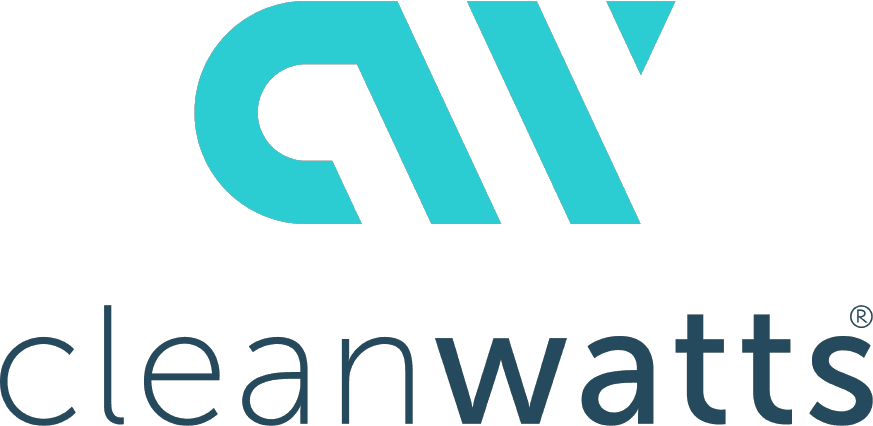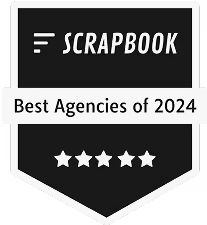
Clean technology is advancing at a rapid pace, with record breaking global investments driving innovation and competition.
But here’s the tea - as the products go to market, the traditional spray and pray marketing just isn’t cutting it anymore. Broad, untargeted campaigns waste resources and fail to engage the key decision makers who actually drive action in b2b cleantech procurement.
In a space where long sales cycles and complex stakeholder networks are the norm, ABM has quickly become a game changer for cleantech digital marketing strategies.
Let’s dive into why this strategy works and how you can get in on the action!
The 2025 Cleantech Marketing Challenge
Okay, let’s be real, marketing cleantech isn’t going to go viral overnight like a TikTok dance challenge trend. Because you’re up against:
🚧Complex technical solutions that are often not impulse buys
🚧Multiple decision makers (often 10+ people!)
🚧High stakes purchases that can make or break budgets
🚧Long sales cycles that test your patience
That’s where ABM for cleantech marketing comes in.
So What is ABM, & Why Should We Care?
ABM is an audience selection and engagement strategy. A powerful laser focused approach - designed to nurture high value prospects, drive conversions efficiently with personalized marketing and sales support.
We can think of it as the difference between mass texting your entire contact list, versus crafting the perfect DM for someone you ACTUALLY want to hear back from. It is tailored, intentional, and way more likely to get a reply!
And it works.
Just look at Personify, a community experience platform for nonprofits. They went all in on ABM, identifying key personas that influence buying decisions and created ultra targeted experiences just for them. Instead of treating every lead the same, they customized digital ads and content for each persona within an account, giving their sales team insight into exactly what content a lead engaged with!
The result was 39x more engaged site visitors and an 850% ROI on marketing sourced revenue.
What’s our takeaway from all this?
Buying decisions aren’t made in a vacuum. ABM helps you speak directly to the entire buying committee, showing each persona exactly how your product solves their pain points.
Why is ABM Critical for Cleantech?
ABM was developed in the world of high ticket, operationally risky B2B technology purchases. The precise approach required of B2B Cleantech marketing strategies is made more effective with ABM. Most importantly, when done right it has been shown to shorten sales cycles and improve deal velocity.
👉Nurture Complex Buying Cycles: Cleantech purchases often require multiple stakeholders and long decision timelines. ABM ensures consistent, personalized engagement throughout. Cleantech marketing strategies that align with ABM can shorten sales cycles and improve stakeholder alignment
👉Maximize ROI: Instead of spending resources on broad, low-converting audiences, you invest in accounts that matter. Cleantech marketing conversion optimization is a key benefit of ABM, ensuring every dollar spent delivers measurable results.
👉 Align Sales & Marketing: With ABM, cleantech marketing and sales alignment move in lockstep, ensuring messaging and outreach complement each other perfectly as opposed to traditional spray and pray tactics, where marketing blasts out generic campaigns and sales teams struggle to convert lukewarm leads.
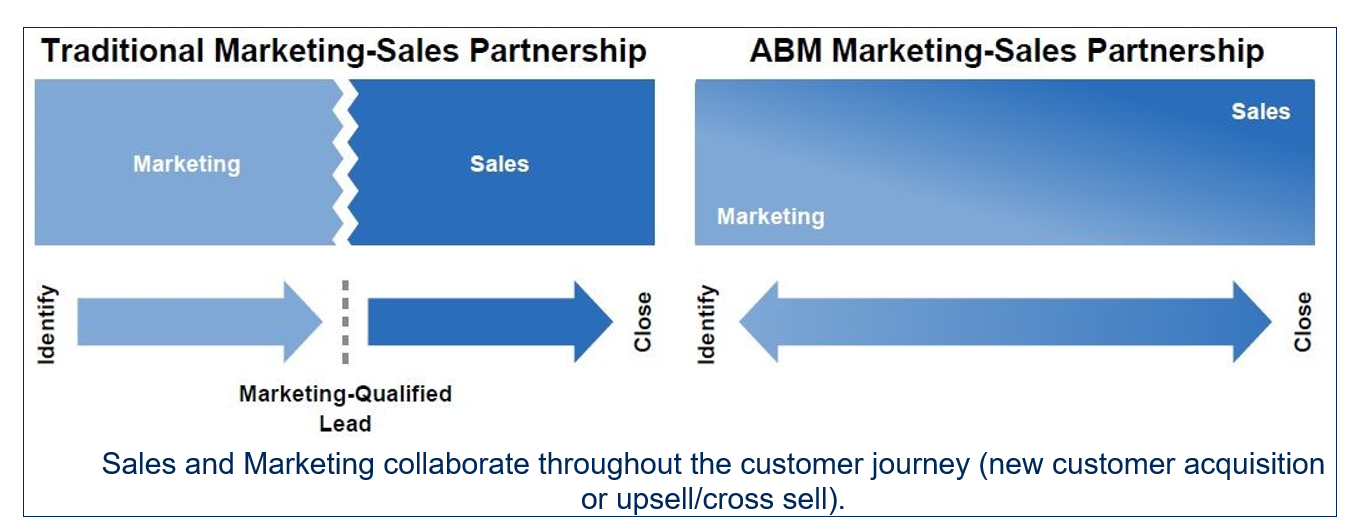
Did you know ❓
Successful ABM programs can see an average increase of 171% in annual contract value compared to non-ABM strategies!
Step by Step: How to Implement ABM in Cleantech
Step #1 Define Your Ideal Customer Profile (ICP)
Not all prospects are created equal. Start by identifying high-potential customers based on. Use cleantech marketing audience segmentation to narrow down further
🔹 Firmographics: Industry, company size, location, and revenue.
Are you targeting large enterprises investing in sustainability or mid-sized firms seeking cost-effective green solutions?
🔹 Technographics: The technology stack they use.
Do they already invest in renewable energy systems, IoT solutions, or carbon management platforms? Understanding their existing tools helps tailor your messaging.
🔹 Business Pain Points: What challenges are they facing?
Are they struggling with high energy costs, emissions compliance, or inefficient operations? Mapping these pain points to your solution strengthens your positioning.
💡 Pro Tip: Leverage first party data (website visits, intent signals) and third party insights (industry reports, competitor analysis) to refine your ICP.
Step #1.2 Leverage LinkedIn’s Advanced Targeting Capabilities
After you have figured out who your ideal customers are, it’s important that you reach out rightly and LinkedIn’s got some killer tools to help you do just that. Here’s how to use LinkedIn to zero in on your perfect audience:
👉Job Function: You can target people based on what they do (like Engineering or Operations) and skip the newbies or interns by excluding entry-level roles.
👉Job Titles: LinkedIn lets you get super specific with job titles. Want to reach Senior Engineers but not Analysts? No problem. You can include or exclude whoever you need to.
👉Location, Location, Location: Only wanna focus on certain areas? LinkedIn’s got you covered. Target specific cities, regions, or even countries to keep your efforts where they matter most.
👉Company Focus: You can also target people working at specific companies or in certain industries like big energy players or mid sized firms looking to go green.
Here’s a glimpse of how we have executed this for one of our clients, targeting a highly specific segment within Upstream Oil and Gas:

Step #2 Choose Your ABM Approach
Depending on your resources an cleantech marketing tools you can adopt one of these:

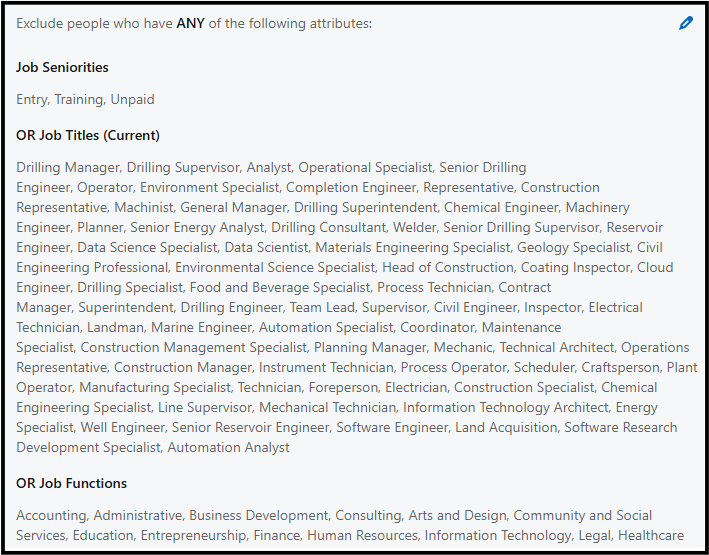
👉One to One: Personalized for VIP accounts.
👉One to Few: Segmented by industry or pain points.
👉Segment Based: Segment based on demographics, behavior, pain points etc
👉One to Many: Automated, broader outreach to mid-tier accounts
Step #3 Build Personalized Engagement Strategies
Each target account should receive highly relevant content, such as:
🔹White Papers on renewable energy regulations.
🔹 Case studies on how your solution improves efficiency.
🔹 Webinars with industry experts discussing sustainable innovations.
The power of impactful content is directly aligned to cleantech demand generation. See how our client, Kathairos Solutions, is killing it with this strategy!
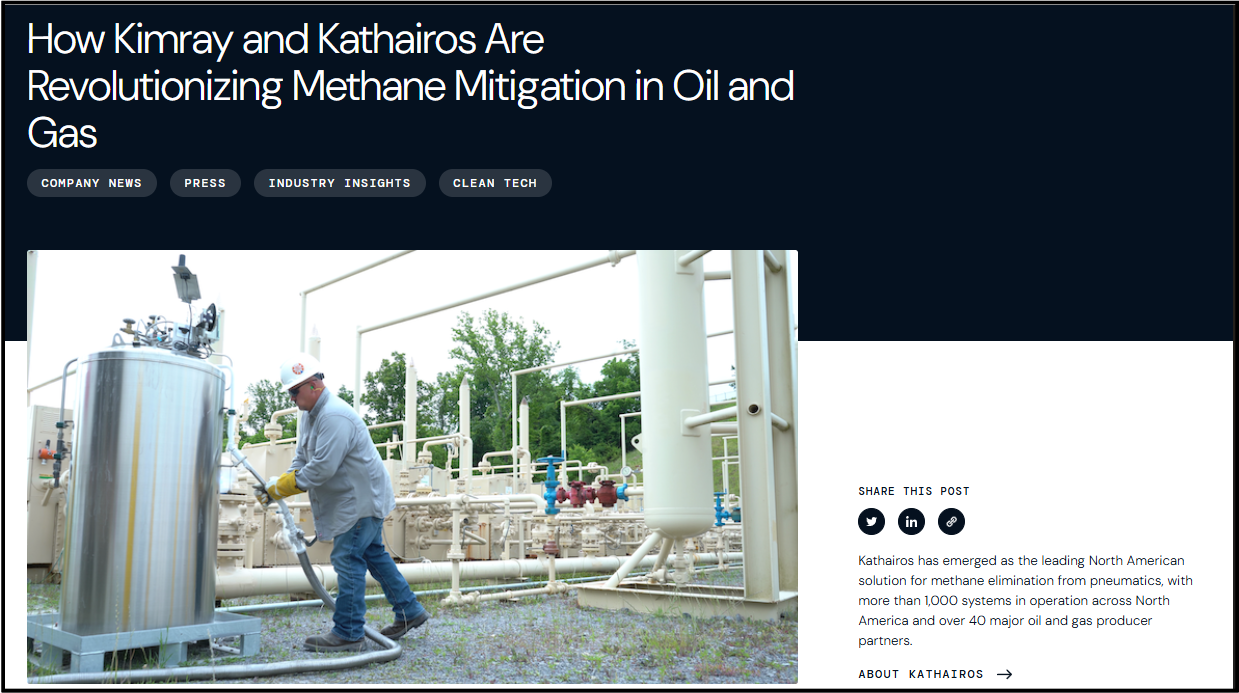
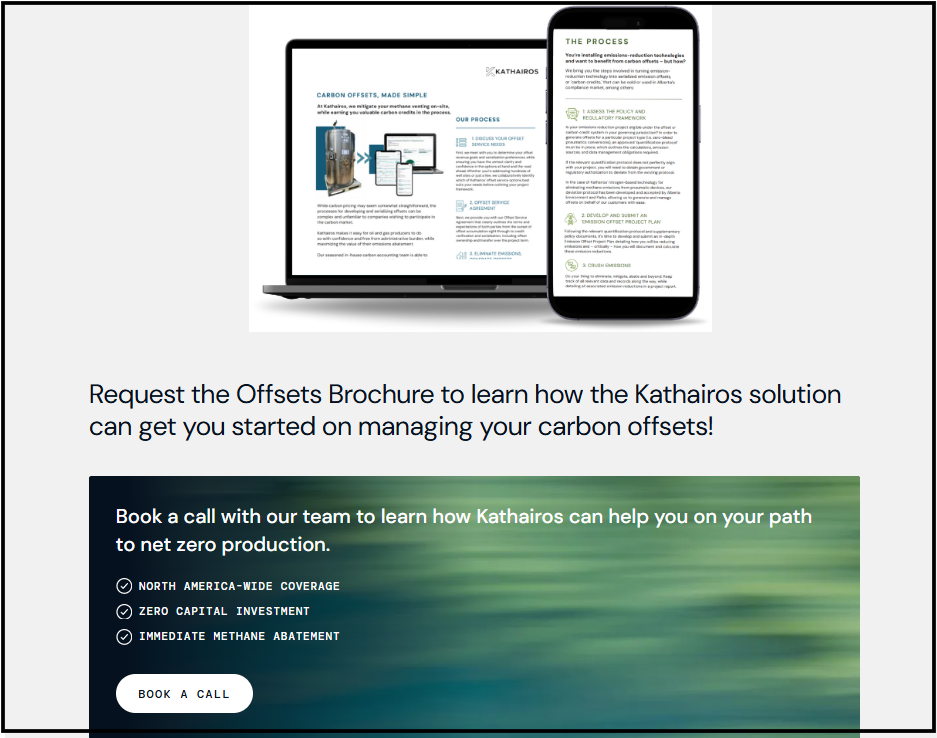
Take a page from our playbook: the example below shows how dynamic content can be tailored to specific roles and challenges within an account.
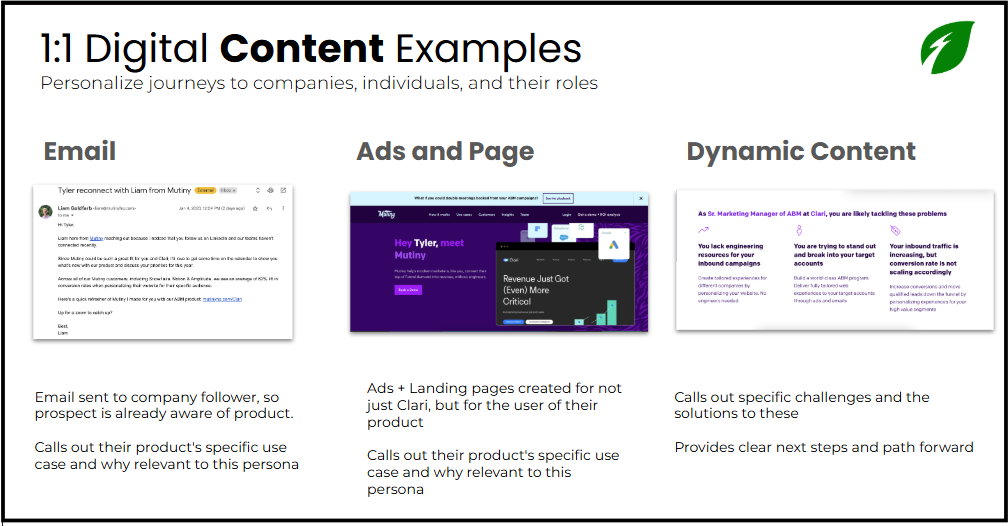
For instance, an email sent to a CIO directly addresses their struggle to integrate systems post-merger, while ads and landing pages highlight solutions to their unique pain points.
This level of personalization ensures your message resonates deeply, bridging the gap between their challenges and your cleantech solution.
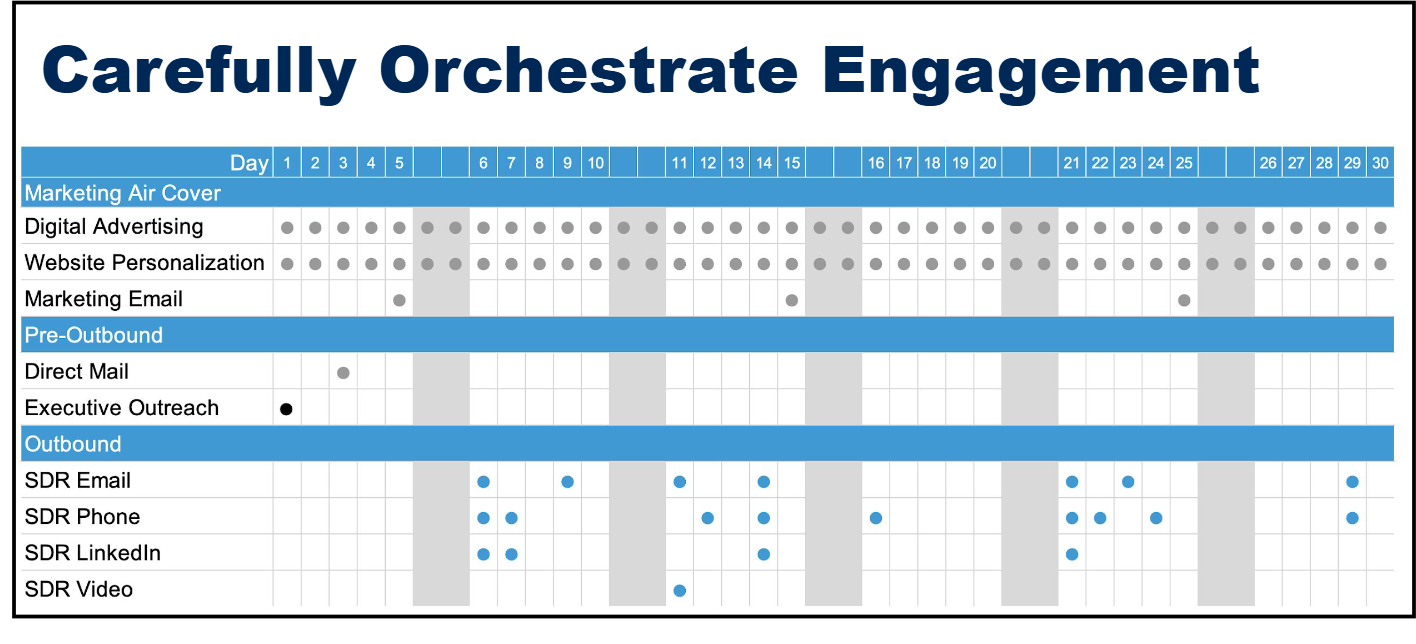
Step #4 Leverage Multi-Touch Engagement
ABM requires a strong ongoing engagement and isn’t a ‘one and done’ deal.
1️⃣ Start with digital ads targeting key decision-makers (paid search, LinkedIn, programmatic display).
2️⃣ Follow up with email outreach, personalized to each account.
3️⃣ Host educational webinars or events to nurture leads.
4️⃣ Support sales with data-driven insights to craft compelling pitches.
It's like conducting an orchestra where every channel plays its part at just the right moment. Digital ads and website personalization set the steady background rhythm, while targeted emails and SDR outreach add those perfectly timed solo performances.
The whole thing is mapped out over 30 days to hit the sweet spot between staying top of mind and avoiding audience fatigue. Want to plan out yours? Get a free strategy session by reaching out to us!
Step #5 Track, Measure, and Optimize
Here’s a quick look at the key metrics to track:
👉Account engagement: Keep an eye on email open rates, ad clicks, and how many people are showing up to your webinars. It shows how interested your account is.
👉Sales cycle length: Are you closing deals faster? Shorter sales cycles mean your ABM efforts are working.
👉Revenue growth: Ultimately, check how much revenue is coming from the accounts you’re targeting with ABM. That’s the real proof that your strategy is paying off. Cleantech marketing performance metrics are your goldmine to keep tweaking your game!
At the end of the day, ABM is all about connecting with the right people in the right way, no fluff, no wasted effort. And for cleantech? It’s a match made in heaven. ABM cuts through the chaos, helping you focus on the accounts that truly matter and delivering the kind of personalized, meaningful engagement that actually moves the needle.
Think about it, cleantech is growing fast, but so is the competition. ABM is your way to stand out, build trust, and show your audience that you GET them!
Stay in the loop
Follow us on LinkedIn for more industry insights and resources to help increase your ROI.




